![[Updated] Guide to Premium Podcasting Top Mic Picks](https://thmb.techidaily.com/580872e4bd4e21da3535470ce3b918e09ae5b8653067a4110ec11928ef11818a.jpg)
"[Updated] Guide to Premium Podcasting Top Mic Picks"

Guide to Premium Podcasting: Top Mic Picks
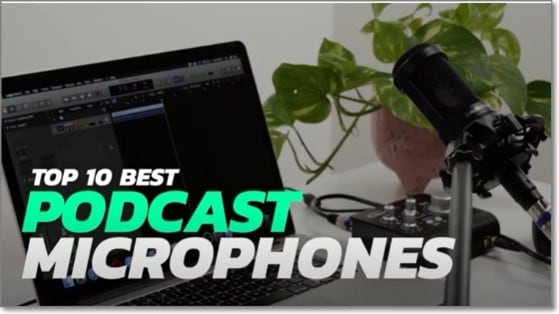
If you are reading this page, you either have a running podcast or plan to start one. Whatever the case, you may need to invest in a good podcast microphone.
Podcasting is all about audio; a good microphone makes a lot of difference in clarity, sharpness, and recording the last word. So, if you are planning to buy a new microphone for a podcast or upgrade an existing one, this article will be a good read to help you make a wide choice.
- Blue Yeti Nano – Premium Dual Pattern Mic
- Samson Q2U – Best budget podcasting microphone
- Shure MV7 Podcast microphone – Feature-rich mic for serious podcasters
- Samson GTrack Pro: Mic for professional recording
- Rode PodMic – The overall best podcasting mic
- Rode NT USB – Durable and User-friendly mic
- AudioTechnica AT2035 - Entry Level XLR Reliable mic
- Elgato Wave III – Streaming Mic for podcasting as well
- Blue Yeti X - Bigger Yeti version
- HyperX Quadcast - USB Gaming mic
Part 1. The 10 Best Microphones for Podcasting in 2024
The market has decent options regarding microphones, with all of them making tall claims about their features and usability. The real challenge here is to single out an overall best-in-class mic, as everyone’s requirements will differ. So instead, we have shortlisted a few standouts for your consideration.
1. Blue Yeti Nano – Premium Dual Pattern Mic
It is an excellent mic that is apt for recording and streaming hassle-free. The features and the device’s aesthetics are also cool and make the videos look appealing. The mic comes with Blue Voice vocal effects that let you record in professional quality. Furthermore, this USB microphone supports multiple pick-up patterns and features built-in headphone output.

What you need to know
- Weight: 139lbs (0.63Kg)
- Pick-up Patterns: Cardioid and Omni pick-up patterns
- Mic type: Dual mic pattern
- Connection type: USB
- Frequency response: 20 Hz to 20 kHz
- Price: $99.99
Unique Features
- Two new mic capsules for detailed and exceptional audio presence.
- Support to high-quality 24-bit/48 kHz recording.
- Support for Blue Voice Effects.
- Works with a wide range of apps
Reasons to avoid
- The pricing is high compared to the other models in a similar category.
- Not suitable for users looking for stereo or bidirectional mode.
- We might have compatibility issues with Apple that no longer uses USB 3, and an adapter might be needed in such situations.
2. Samson Q2U – Best budget podcasting microphone
Considering its price and basic features, Q2U can be regarded as the best entry-level podcasting mic. The device uses the cardioid pick-up pattern capable of ignoring the ambient noise and picking up the live recording vocals. In addition, the mic offers both USB and XLR connectors so that it can be used in simple setups and with mixers.
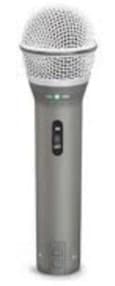
What you need to know
- Weight: 320g
- Pick-up Patterns: Cardioid Pattern
- Mic type: Dynamic
- Connection type: USB and XLR connection
- Frequency response: 50Hz to 15 kHz
- Price: $59.99
Unique Features
- Good features for the price-point it comes for.
- It looks like a classic dynamic mic
- The bundle pack comes with all podcasting essentials and accessories.
- Offers both USB and XLR connection.
- Features headphone output and volume controls.
Reasons to avoid
- Does not come with a phone and tablet adapter.
- Not apt as a studio microphone.
 EmEditor Professional (Lifetime License, non-store app)
EmEditor Professional (Lifetime License, non-store app)
3. Shure MV7 Podcast microphone – Feature-rich mic for serious podcasters
It is a dynamic device apt for serious podcasters willing to spend a good amount in return for the features. The device offers a USB and XLR connection and comes with Shure’s voice isolation technology, along with Auto Level Mode, which allows for capturing high-quality professional audio. The mic also offers live-signal processing.
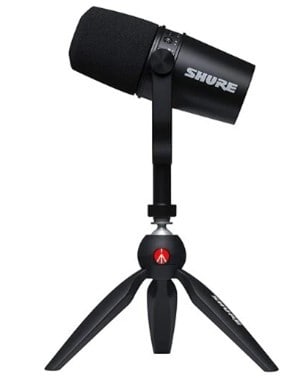
What you need to know
- Weight: 1.21lb (0.55Kg)
- Pick-up Patterns: Cardioid
- Mic type: Dynamic
- Connection type: USB and XLR
- Frequency response:50 Hz to 16kHz
- Price: $224
Unique Features
- It comes with built-in headphone monitoring
- Support Voice Isolation Technology and Auto Level Mode
- Versatile device
Reasons to avoid
- Heavy on pockets, not that portable.
4. Samson GTrack Pro : Mic for professional recording
If you want to focus more on the recording and less on the process, this excellent mic will take care of everything. It is a USB-based device that features instrument input and a mixer. Audio can be recorded in 24-bit/96 kHz so that recordings are clear and high-quality.
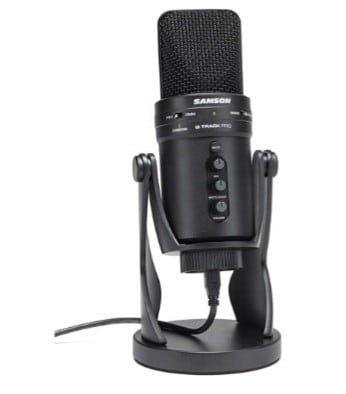
What you need to know
- Weight: 3.52 lb(1.6Kg)
- Pick-up Patterns: Cardioid, bidirectional, and omnidirectional.
- Mic type: Plug n Play
- Connection type: USB for Mac and PC devices.
- Frequency response: 50Hz to 20 kHz
- Price: $95
Unique Features
- The audio interface is good for recording the bass, guitar, and other line-level devices.
- The mono/2-Track switch allows the recording mic and instrument to be simultaneous.
- Comes with a full-featured mixer offering Mic and instruments voice control independently.
- With a mute button, it silences the input signals.
Reasons to avoid
- It is quite heavy and would need a sturdy mounting stand.
 SwifDoo PDF Perpetual (2-PC) Free upgrade. No monthly fees ever.
SwifDoo PDF Perpetual (2-PC) Free upgrade. No monthly fees ever.
5. Rode PodMic – The overall best podcasting mic
Don’t judge this mic by its size. Though small, the device is powerful and packed with high-quality audio recording features. Polished and clear sound can be recorded using this device, and that too without much processing. Easy to use and set up, this XLR mic can be great for style, sound, and price point.
What you need to know
- Weight: 2.1 lb (937 grams)
- Pick-up Patterns: Cardioid
- Mic type: Condenser
- Connection type: XLR
- Frequency response: 20 Hz to 20 kHz
- Price: $99
Unique Features
- XLR connection for pro recording.
- Comes with built-in damping and pop filters.
- The mount hinges facilitate flexible movement and positioning.
- A dynamic mic with rugged all-metal construction.
- Offers high-quality and clear sound.
Reasons to avoid
- There are no built-in audio filters.
- It is an XLR device, not apt for beginners.
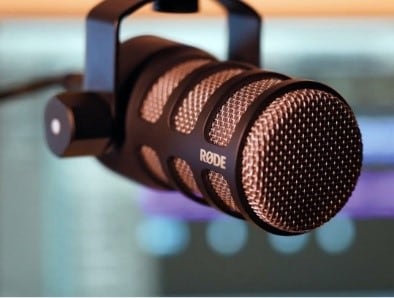
6. Rode NT USB – Durable and User-friendly mic
This USB-based mic from Rode is solid and durable, capable of recording vocals, games, instruments, and much more in decent quality. Also, the high-power headphone output of the device offers zero latency.
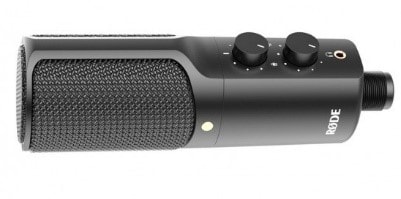
What you need to know
- Weight: 1.14lb (520g)
- Pick-up Patterns: Cardioid
- Mic type: Condenser
- Connection type: USB
- Frequency response: 20 Hz to 20 kHz
- Price: $120+
Unique Features
- Comes with a professional pop filter and tripod.
- Features onboard monitor level and headphone mix controls.
- Allows high-quality audio recording with extended crispiness and responses.
- Good looking premium design.
Reasons to avoid
- The tripod is weak and unstable
- There is no gain knob
- The pricy USB-only device
7. AudioTechnica AT2035 - Entry Level XLR Reliable mic
It will be a good choice if you want an entry-level device with all the needed features. The price point is user-friendly, and this mic with a solid construction offers versatile and quality sound. The mic is apt for recording the vocals as well as instruments.
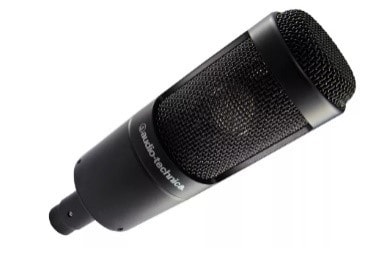
What you need to know
- Weight: 403gms
- Pick-up Patterns: Cardioid
- Mic type: Condenser
- Connection type: XLR
- Frequency response: 20Hz to 20kHz
- Price: $149
Unique Features
- Value for money device.
- Apt for recording vocals as well as instruments.
- Comes with a shock mount.
- It is a great starter package with an XLR cable, a boom arm for desk connection, and headphones.
Reasons to avoid
- Single polar pattern
- There are many other devices available at the price point it comes for.
8. Elgato Wave III – Streaming Mic for podcasting as well
Though this is a streaming mic, it is considered a decent entry-level podcasting device that allows recording good quality sound. Moreover, the retro look of the mic makes it an excellent addition to any studio. The mic works with Elgato Stream Deck, which helps make the sound adjustments live. It is a USB-based mic that comes with a capacitive mute button.
It will help you to write dynamic data reports easily, to construct intuitive dashboards or to build a whole business intelligence cockpit.
KoolReport Pro package goes with Full Source Code, Royal Free, ONE (1) Year Priority Support, ONE (1) Year Free Upgrade and 30-Days Money Back Guarantee.
Developer License allows Single Developer to create Unlimited Reports, deploy on Unlimited Servers and able deliver the work to Unlimited Clients.
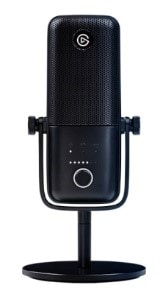
What you need to know
- Weight: 280 g
- Pick-up Patterns: Cardioid
- Mic type: Condenser
- Connection type: USB
- Frequency response: 70Hz to 20kHz
- Price: $159.99
Unique Features
- Multifunction dial for controlling the input and output gain.
- It comes with a pop filter for reducing the plosive noise.
- Support Wave Link software that offers control over the streaming content.
Reasons to avoid
- Lack of versatility.
- More options are available in this price range.
9. Blue Yeti X - Bigger Yeti version
It is one of the best USB version mics available around. The device has four condenser mic capsules that offer rich and warm vocal sounds. In addition, the mic comes with a high-resolution meter for the audio, and the intelligent control knob and its smart and robust build make it popular among users.
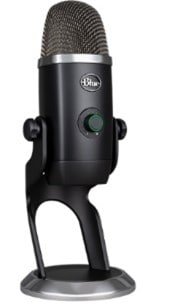
What you need to know
- Weight: 2.8lb (1.27 kg)
- Pick-up Patterns: Multi-pattern
- Mic type: Condenser
- Connection type: USB
- Frequency response: 20 Hz to 20 kHz
- Price: 169.99
Unique Features
- Multi-pattern support for solid and versatile audio requirements.
- Comes with LED live metering.
- DSP-free.
- The recording software is included.
Reasons to avoid
- There are no pop-filter or adapters for the standard mic stand.
- Expensive than the standard Yeti devices.
10. HyperX Quadcast - USB Gaming mic
If you scroll across the best gaming mic, you will surely come across HyperX Quadcast. The features are also engaging with a strong build, red design, and RGB lighting effects. In addition, the mic comes with a built-in anti-vibration shock mount that allows excellent handling of noises.
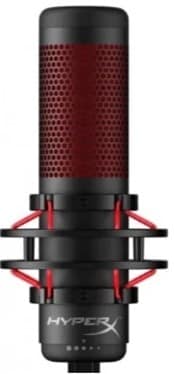
What you need to know
- Weight: 254g
- Pick-up Patterns: Multi-pattern
- Mic type: Condenser
- Connection type: USB
- Frequency response: 20 Hz to 20 kHz
- Price: $139
Unique Features
- Support multi-polar pattern.
- Attractive and cool-looking design.
- Unique RGB lighting feature.
- The kit includes the built-in pop filter and the shock mount.
Reasons to avoid
- Sample Rate and the Bit Depth are short recordings only at 48kHz/16-bt
- A shock mount is made of plastic
Part 2. How to choose the best podcast microphone for you?
Getting confused is standard with multiple types and models available for podcast microphones. Though the essential function of all these devices is the same, several features differentiate between them and make each one suitable for a certain task or requirement. So, to help you buy the best one, the below checklist will be of great help.
1. XLR Vs. USB microphone
The first important thing you would need to consider before making the purchase is how the microphone will be connected for the recording. The most commonly used mics are those with a USB and plug-and-play devices. These are simple to use and do not require any advanced and technical sound knowledge. Just plug these mics into your laptop and get the recording started. Since USB mics are pocket-friendly, they are generally the first choices when you start your podcasting journey.
On the other hand, the mics with XLR connectors are advanced devices that come with an audio interface or a podcast mixer. With these, multiple mics can be connected simultaneously and offer control over the sound levels. To use these microphones, extra equipment and knowledge about the audio and sounds are needed to make the best of them.
There are a few mics available that offer both USB as well as XLR connections.
2. Number of people using the mic at the same time
Another important factor for mic determination is the number of people using the mic at a time. The Cardioid pick-up pattern devices are apt for situations when a single person has to speak on the mic directly. On the other hand, if two or more people are using the mic, you would need to choose the one capable of multiple-pickup patterns.
3. Included audio software
Another deciding factor is the audio software. Depending on your requirements, choose a simple device without any included software or go for one with audio editing or music production software.
4. Budget
Last but not least is the budget for your mic. You need to set a budget and then accordingly check which is the best mic that fits into your category.
Part 3. What else do you need to start podcasting?
Above, we have discussed the importance of a good podcasting mic and the available varieties and models. In addition, another important thing you would need to create an excellent podcast is a professional audio recording and editing tool. Good software helps customize, edit, and create a polished version of your podcast.
One such program that we recommend here is Wondershare Filmora . Though video editing software, it also offers excellent audio recording and editing features. Furthermore, the software is compatible with Mac and Windows systems, and once installed, it will help you get the desired task done effortlessly.
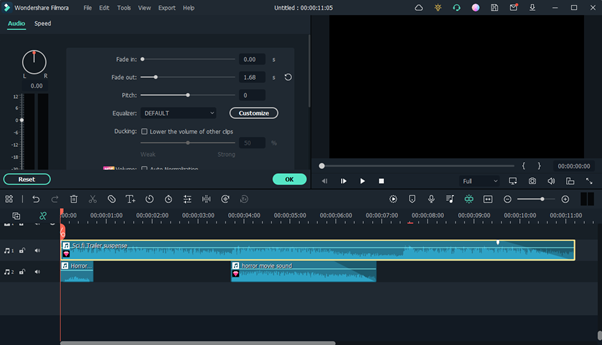
Let’s check out some of the critical audio-related features of Wondershare Filmora
- The shortcut key saves you time while editing podcasts.
- An array of audio effects to further enhance your podcast, like big room effects, minor room effects, phone Audio effects, and more.
- The Text to Speech feature works as a wonderful option for text-to-voice conversion. Again, 10 different voices to choose from.
- Also, the Speech to Text feature enables your podcast show more accessible.
Step by Step Guide for using audio-related features of Wondershare Filmora
Step1 Download, install, and launch the Wondershare Filmora software on your system. Enter the player panel, choose File > Record Media, and then choose the Webcam option.

WPS Office Premium ( File Recovery, Photo Scanning, Convert PDF)–Yearly

Step2 Next, record the Full Screen, Custom, or Target Window as desired. Here you need to select if you want to record the audio from the microphone or use the computer system. Finally, choose the icon of the option desired.
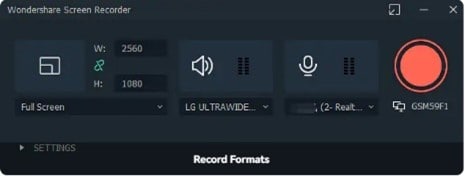
Step3 Next, click the REC button, and the recording will start with a countdown of 3 seconds. Stop when the recording is done, and the recorded file can be checked from the media library.
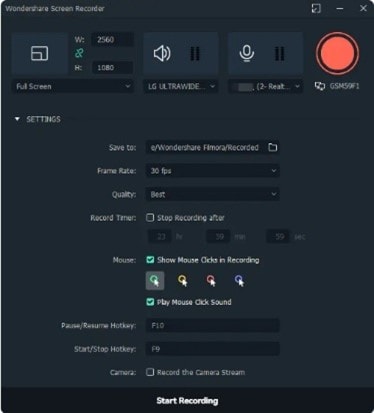
Steps to adjust and edit audio using Wondershare Filmora
Step1 Launch the software and then have access to the Adjust Audio Interface. You can choose any of the following 3 options.
- Double-click on the audio clip
- From the top navigation bar, choose Tools > Audio> Adjust Audio
- Right-click on the desired audio and then select audio> Adjust audio
Step2 Next, the audio adjusting window will open from where you can make the desired changes using the features – Balance/Pan control, volume control, volume keyframe, fade-in, fade-out, pitch, equalizer, denoise, ducking, and volume.
Step3 After the desired changes are made, click on the OK button to confirm the same and save the audio file.
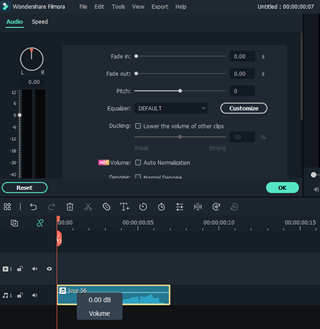
Steps to add audio effects using Wondershare Filmora
Step1 Launch the software, choose the desired audio file from the media library and drag it to the time. Next, go to Effects > Audio Effects.

Step2 Next, you will find the 5 sound effect samples – Big Room, Lobby, Small Room, Echo, and Phone. Download these effects and add them to your audio file, tab on the Add icon or the clip.
Step3 The settings of these audio effects can also be adjusted by double-clicking on the timeline clip and then going to the Audio Effects option under the Audio tab.
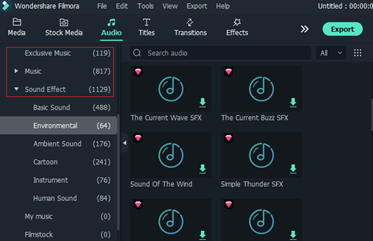
Step4 Confirm the added effect and save the audio file.
The detailed steps can be checked in Wondershare Filmora Audio Effects Guide.
So, we hope all your queries related to podcast microphones are resolved. Now, it’s time to invest in a good microphone and prepare for other podcasting equipment.
Free Download For Win 7 or later(64-bit)
Free Download For macOS 10.14 or later
Part 1. The 10 Best Microphones for Podcasting in 2024
The market has decent options regarding microphones, with all of them making tall claims about their features and usability. The real challenge here is to single out an overall best-in-class mic, as everyone’s requirements will differ. So instead, we have shortlisted a few standouts for your consideration.
 FX PRO (Gold Robot + Silver Robot(Basic Package))
FX PRO (Gold Robot + Silver Robot(Basic Package))
1. Blue Yeti Nano – Premium Dual Pattern Mic
It is an excellent mic that is apt for recording and streaming hassle-free. The features and the device’s aesthetics are also cool and make the videos look appealing. The mic comes with Blue Voice vocal effects that let you record in professional quality. Furthermore, this USB microphone supports multiple pick-up patterns and features built-in headphone output.

What you need to know
- Weight: 139lbs (0.63Kg)
- Pick-up Patterns: Cardioid and Omni pick-up patterns
- Mic type: Dual mic pattern
- Connection type: USB
- Frequency response: 20 Hz to 20 kHz
- Price: $99.99
Unique Features
- Two new mic capsules for detailed and exceptional audio presence.
- Support to high-quality 24-bit/48 kHz recording.
- Support for Blue Voice Effects.
- Works with a wide range of apps
Reasons to avoid
- The pricing is high compared to the other models in a similar category.
- Not suitable for users looking for stereo or bidirectional mode.
- We might have compatibility issues with Apple that no longer uses USB 3, and an adapter might be needed in such situations.
2. Samson Q2U – Best budget podcasting microphone
Considering its price and basic features, Q2U can be regarded as the best entry-level podcasting mic. The device uses the cardioid pick-up pattern capable of ignoring the ambient noise and picking up the live recording vocals. In addition, the mic offers both USB and XLR connectors so that it can be used in simple setups and with mixers.

What you need to know
- Weight: 320g
- Pick-up Patterns: Cardioid Pattern
- Mic type: Dynamic
- Connection type: USB and XLR connection
- Frequency response: 50Hz to 15 kHz
- Price: $59.99
Unique Features
- Good features for the price-point it comes for.
- It looks like a classic dynamic mic
- The bundle pack comes with all podcasting essentials and accessories.
- Offers both USB and XLR connection.
- Features headphone output and volume controls.
Reasons to avoid
- Does not come with a phone and tablet adapter.
- Not apt as a studio microphone.
3. Shure MV7 Podcast microphone – Feature-rich mic for serious podcasters
It is a dynamic device apt for serious podcasters willing to spend a good amount in return for the features. The device offers a USB and XLR connection and comes with Shure’s voice isolation technology, along with Auto Level Mode, which allows for capturing high-quality professional audio. The mic also offers live-signal processing.

What you need to know
- Weight: 1.21lb (0.55Kg)
- Pick-up Patterns: Cardioid
- Mic type: Dynamic
- Connection type: USB and XLR
- Frequency response:50 Hz to 16kHz
- Price: $224
Unique Features
- It comes with built-in headphone monitoring
- Support Voice Isolation Technology and Auto Level Mode
- Versatile device
Reasons to avoid
- Heavy on pockets, not that portable.
4. Samson GTrack Pro : Mic for professional recording
If you want to focus more on the recording and less on the process, this excellent mic will take care of everything. It is a USB-based device that features instrument input and a mixer. Audio can be recorded in 24-bit/96 kHz so that recordings are clear and high-quality.

What you need to know
- Weight: 3.52 lb(1.6Kg)
- Pick-up Patterns: Cardioid, bidirectional, and omnidirectional.
- Mic type: Plug n Play
- Connection type: USB for Mac and PC devices.
- Frequency response: 50Hz to 20 kHz
- Price: $95
Unique Features
- The audio interface is good for recording the bass, guitar, and other line-level devices.
- The mono/2-Track switch allows the recording mic and instrument to be simultaneous.
- Comes with a full-featured mixer offering Mic and instruments voice control independently.
- With a mute button, it silences the input signals.
Reasons to avoid
- It is quite heavy and would need a sturdy mounting stand.
5. Rode PodMic – The overall best podcasting mic
Don’t judge this mic by its size. Though small, the device is powerful and packed with high-quality audio recording features. Polished and clear sound can be recorded using this device, and that too without much processing. Easy to use and set up, this XLR mic can be great for style, sound, and price point.
What you need to know
- Weight: 2.1 lb (937 grams)
- Pick-up Patterns: Cardioid
- Mic type: Condenser
- Connection type: XLR
- Frequency response: 20 Hz to 20 kHz
- Price: $99
Unique Features
- XLR connection for pro recording.
- Comes with built-in damping and pop filters.
- The mount hinges facilitate flexible movement and positioning.
- A dynamic mic with rugged all-metal construction.
- Offers high-quality and clear sound.
Reasons to avoid
- There are no built-in audio filters.
- It is an XLR device, not apt for beginners.

6. Rode NT USB – Durable and User-friendly mic
This USB-based mic from Rode is solid and durable, capable of recording vocals, games, instruments, and much more in decent quality. Also, the high-power headphone output of the device offers zero latency.

What you need to know
- Weight: 1.14lb (520g)
- Pick-up Patterns: Cardioid
- Mic type: Condenser
- Connection type: USB
- Frequency response: 20 Hz to 20 kHz
- Price: $120+
Unique Features
- Comes with a professional pop filter and tripod.
- Features onboard monitor level and headphone mix controls.
- Allows high-quality audio recording with extended crispiness and responses.
- Good looking premium design.
Reasons to avoid
- The tripod is weak and unstable
- There is no gain knob
- The pricy USB-only device
7. AudioTechnica AT2035 - Entry Level XLR Reliable mic
It will be a good choice if you want an entry-level device with all the needed features. The price point is user-friendly, and this mic with a solid construction offers versatile and quality sound. The mic is apt for recording the vocals as well as instruments.

What you need to know
- Weight: 403gms
- Pick-up Patterns: Cardioid
- Mic type: Condenser
- Connection type: XLR
- Frequency response: 20Hz to 20kHz
- Price: $149
Unique Features
- Value for money device.
- Apt for recording vocals as well as instruments.
- Comes with a shock mount.
- It is a great starter package with an XLR cable, a boom arm for desk connection, and headphones.
Reasons to avoid
- Single polar pattern
- There are many other devices available at the price point it comes for.
8. Elgato Wave III – Streaming Mic for podcasting as well
Though this is a streaming mic, it is considered a decent entry-level podcasting device that allows recording good quality sound. Moreover, the retro look of the mic makes it an excellent addition to any studio. The mic works with Elgato Stream Deck, which helps make the sound adjustments live. It is a USB-based mic that comes with a capacitive mute button.

What you need to know
- Weight: 280 g
- Pick-up Patterns: Cardioid
- Mic type: Condenser
- Connection type: USB
- Frequency response: 70Hz to 20kHz
- Price: $159.99
Unique Features
- Multifunction dial for controlling the input and output gain.
- It comes with a pop filter for reducing the plosive noise.
- Support Wave Link software that offers control over the streaming content.
Reasons to avoid
- Lack of versatility.
- More options are available in this price range.
 HD Video Converter Factory Pro
HD Video Converter Factory Pro
9. Blue Yeti X - Bigger Yeti version
It is one of the best USB version mics available around. The device has four condenser mic capsules that offer rich and warm vocal sounds. In addition, the mic comes with a high-resolution meter for the audio, and the intelligent control knob and its smart and robust build make it popular among users.

What you need to know
- Weight: 2.8lb (1.27 kg)
- Pick-up Patterns: Multi-pattern
- Mic type: Condenser
- Connection type: USB
- Frequency response: 20 Hz to 20 kHz
- Price: 169.99
Unique Features
- Multi-pattern support for solid and versatile audio requirements.
- Comes with LED live metering.
- DSP-free.
- The recording software is included.
Reasons to avoid
- There are no pop-filter or adapters for the standard mic stand.
- Expensive than the standard Yeti devices.
10. HyperX Quadcast - USB Gaming mic
If you scroll across the best gaming mic, you will surely come across HyperX Quadcast. The features are also engaging with a strong build, red design, and RGB lighting effects. In addition, the mic comes with a built-in anti-vibration shock mount that allows excellent handling of noises.

What you need to know
- Weight: 254g
- Pick-up Patterns: Multi-pattern
- Mic type: Condenser
- Connection type: USB
- Frequency response: 20 Hz to 20 kHz
- Price: $139
Unique Features
- Support multi-polar pattern.
- Attractive and cool-looking design.
- Unique RGB lighting feature.
- The kit includes the built-in pop filter and the shock mount.
Reasons to avoid
- Sample Rate and the Bit Depth are short recordings only at 48kHz/16-bt
- A shock mount is made of plastic
Part 2. How to choose the best podcast microphone for you?
Getting confused is standard with multiple types and models available for podcast microphones. Though the essential function of all these devices is the same, several features differentiate between them and make each one suitable for a certain task or requirement. So, to help you buy the best one, the below checklist will be of great help.
1. XLR Vs. USB microphone
The first important thing you would need to consider before making the purchase is how the microphone will be connected for the recording. The most commonly used mics are those with a USB and plug-and-play devices. These are simple to use and do not require any advanced and technical sound knowledge. Just plug these mics into your laptop and get the recording started. Since USB mics are pocket-friendly, they are generally the first choices when you start your podcasting journey.
On the other hand, the mics with XLR connectors are advanced devices that come with an audio interface or a podcast mixer. With these, multiple mics can be connected simultaneously and offer control over the sound levels. To use these microphones, extra equipment and knowledge about the audio and sounds are needed to make the best of them.
There are a few mics available that offer both USB as well as XLR connections.
2. Number of people using the mic at the same time
Another important factor for mic determination is the number of people using the mic at a time. The Cardioid pick-up pattern devices are apt for situations when a single person has to speak on the mic directly. On the other hand, if two or more people are using the mic, you would need to choose the one capable of multiple-pickup patterns.
3. Included audio software
Another deciding factor is the audio software. Depending on your requirements, choose a simple device without any included software or go for one with audio editing or music production software.
4. Budget
Last but not least is the budget for your mic. You need to set a budget and then accordingly check which is the best mic that fits into your category.
Part 3. What else do you need to start podcasting?
Above, we have discussed the importance of a good podcasting mic and the available varieties and models. In addition, another important thing you would need to create an excellent podcast is a professional audio recording and editing tool. Good software helps customize, edit, and create a polished version of your podcast.
One such program that we recommend here is Wondershare Filmora . Though video editing software, it also offers excellent audio recording and editing features. Furthermore, the software is compatible with Mac and Windows systems, and once installed, it will help you get the desired task done effortlessly.

Let’s check out some of the critical audio-related features of Wondershare Filmora
- The shortcut key saves you time while editing podcasts.
- An array of audio effects to further enhance your podcast, like big room effects, minor room effects, phone Audio effects, and more.
- The Text to Speech feature works as a wonderful option for text-to-voice conversion. Again, 10 different voices to choose from.
- Also, the Speech to Text feature enables your podcast show more accessible.
Step by Step Guide for using audio-related features of Wondershare Filmora
Step1 Download, install, and launch the Wondershare Filmora software on your system. Enter the player panel, choose File > Record Media, and then choose the Webcam option.

Step2 Next, record the Full Screen, Custom, or Target Window as desired. Here you need to select if you want to record the audio from the microphone or use the computer system. Finally, choose the icon of the option desired.

Step3 Next, click the REC button, and the recording will start with a countdown of 3 seconds. Stop when the recording is done, and the recorded file can be checked from the media library.

Steps to adjust and edit audio using Wondershare Filmora
Step1 Launch the software and then have access to the Adjust Audio Interface. You can choose any of the following 3 options.
- Double-click on the audio clip
- From the top navigation bar, choose Tools > Audio> Adjust Audio
- Right-click on the desired audio and then select audio> Adjust audio
Step2 Next, the audio adjusting window will open from where you can make the desired changes using the features – Balance/Pan control, volume control, volume keyframe, fade-in, fade-out, pitch, equalizer, denoise, ducking, and volume.
Step3 After the desired changes are made, click on the OK button to confirm the same and save the audio file.

Steps to add audio effects using Wondershare Filmora
Step1 Launch the software, choose the desired audio file from the media library and drag it to the time. Next, go to Effects > Audio Effects.

Step2 Next, you will find the 5 sound effect samples – Big Room, Lobby, Small Room, Echo, and Phone. Download these effects and add them to your audio file, tab on the Add icon or the clip.
Step3 The settings of these audio effects can also be adjusted by double-clicking on the timeline clip and then going to the Audio Effects option under the Audio tab.

Step4 Confirm the added effect and save the audio file.
The detailed steps can be checked in Wondershare Filmora Audio Effects Guide.
So, we hope all your queries related to podcast microphones are resolved. Now, it’s time to invest in a good microphone and prepare for other podcasting equipment.
Free Download For Win 7 or later(64-bit)
Free Download For macOS 10.14 or later
- Title: [Updated] Guide to Premium Podcasting Top Mic Picks
- Author: Jeffrey
- Created at : 2024-08-21 09:25:26
- Updated at : 2024-08-22 09:25:26
- Link: https://some-knowledge.techidaily.com/updated-guide-to-premium-podcasting-top-mic-picks/
- License: This work is licensed under CC BY-NC-SA 4.0.

 WinUtilities Pro
WinUtilities Pro KoolReport Pro is an advanced solution for creating data reports and dashboards in PHP. Equipped with all extended packages , KoolReport Pro is able to connect to various datasources, perform advanced data analysis, construct stunning charts and graphs and export your beautiful work to PDF, Excel, JPG or other formats. Plus, it includes powerful built-in reports such as pivot report and drill-down report which will save your time in building ones.
KoolReport Pro is an advanced solution for creating data reports and dashboards in PHP. Equipped with all extended packages , KoolReport Pro is able to connect to various datasources, perform advanced data analysis, construct stunning charts and graphs and export your beautiful work to PDF, Excel, JPG or other formats. Plus, it includes powerful built-in reports such as pivot report and drill-down report which will save your time in building ones. 
 SwifDoo PDF 2-Year Plan
SwifDoo PDF 2-Year Plan Glarysoft File Recovery Pro Annually - Helps to recover your lost file/data, even permanently deleted data.
Glarysoft File Recovery Pro Annually - Helps to recover your lost file/data, even permanently deleted data.
 Jutoh is an ebook creator for Epub, Kindle and more. It’s fast, runs on Windows, Mac, and Linux, comes with a cover design editor, and allows book variations to be created with alternate text, style sheets and cover designs.
Jutoh is an ebook creator for Epub, Kindle and more. It’s fast, runs on Windows, Mac, and Linux, comes with a cover design editor, and allows book variations to be created with alternate text, style sheets and cover designs. 